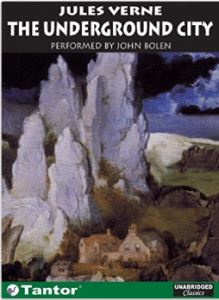 The Underground City: A Little Known Jules Verne Story
The Underground City: A Little Known Jules Verne Story
Author: Jules Verne
Thirteen years after the publication of Journey to the Center of the Earth, another little known subterranean epic is penned by Verne entitled The Children of the Cavern, or as it is sometimes known, The Underground City. When a vast mine owned by a rich and experimental engineer, one James Starr, runs out of coal, it’s on to the next adventure for everyone except the Fords. Old Ford, the foreman and strange denizen of the deep, moves his family 1500 feet underground to dwell in the old mine, shunning the world for the stark beauties of a dismal realm. Ford also has another suspicion: despite the strange doings in the mine that intimate they are not as alone as they would like, he’s searched and searched and just may have found evidence of another coal vein. Seeking to bring back the glory days of mining, he contacts James Starr and the duo do some sleuthing, stumbling upon an old mystery and a child of the dark, one starry eyed Nell. Harry, old Ford’s young son, is intrigued by the maiden and inspired to discover if the mystery of the mine relates to faeries and fire maidens or perhaps something more sinister and unexpected.
It’s a good blurb, although not typical Verne. Of course, we get our fair share of science and then some. We learn everything there is to know about coal mining circa 1877 and the formation of coal and the explosive gas (fire damp) that heralds its nearness and endangers the crews. Yet, the feeling of the story is more prevalent than science, and this is where it loses its narrative thrust, at least to me. Mining is described in glowing terms, old Ford wanting to resume his arduous existence and not satisfied for a day away from work. Now, I’ve never been down in a coal mine myself, but history and common knowledge leads me to believe that coal mining was a hard life, backbreaking and dangerous. Yet here, in the Underground City, Verne shines like an exuberant advertiser singing the praises of the simple, coal mining life with all the Norman Rockwell hues. It’s just . . . ignorant and wrong. How many men have died in mines such as the one described? How much slag heaped onto earth, destroying valleys and homes? How much coal has blackened the lungs of exhausted workers, toiling in the darkness?
The virtue of mining and living underground is extolled, with unrealistic, stereotypical dialogue and flat characters who live to work and work to live. Compounded with these not-so-realistic caricatures, a sudden love story is thrown into the mix and while some of the elements are entertaining, such as Nell’s introduction into the sunlight world and her literal choice between darkness and light, the lack of realism and the stagnant, overly virtuous nature of the adventure left me twitching with boredom. Following on the heels of my first experience with Journey to the Center of the Earth it was a disappointment, especially since it sports Verne’s name.
The mystery of the mine is structured, a promising outline with a solution that is rapidly unveiled leaving many loose threads and inexplicable occurrences. It’s promising, downright entertaining in some segments but, yet, somehow incomplete.
My disenchantment was furthered by the audio book version I snatched from the library. John Bolen, the narrator of my edition, drones in the most exceptional monotone. He does occasionally spice the narrative up with an exceptionally bad rendition of a Scottish accent. His vapidity and dullness could destroy even the best story, and since The Underground City isn’t Verne’s most well-known work for evident reasons, the style of reading further reduces the listener’s ability to immerse in the tale. A disappointing installment, The Underground City is a comparatively average, unmemorable tale for an artist such as Verne. Mostly of interest to fans of the author and anyone with a coal obsession.
- Frances Carden
- Book Vs Movie: The Shining - April 6, 2020
- Thankful For Great Cozy Mysteries - December 13, 2019
- Cozy Mysteries for a Perfect Fall - October 20, 2019


